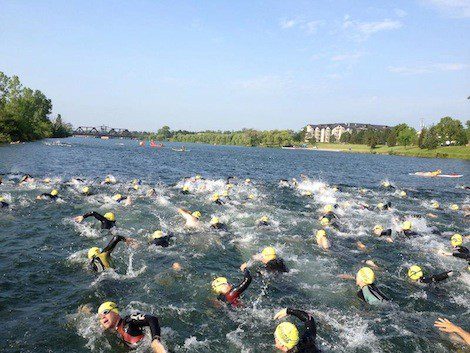Open Water Swimming Tips
Some tips that will make your next lake or ocean swim easier.

Open Water Tips
Most of us don’t have the luxury of having either a beautiful lake or the ocean close by in order to practice our open water swims. That means that the majority of our swimming is done in a pool, which can be quite different to what we experience once we hit either a lake or the ocean on race day. The more you can practice in open water, the more comfortable you’re going to be doing it. Here are a few tips that can help during your next open-water effort:
Wetsuit Fit
Most triathlon swims in Canada take place in water cool enough to allow wetsuits. A proper-fitting wetsuit can improve your swim time by up to 20 per cent, according to some experts. Make sure you buy a wetsuit from a reputable dealer who can help ensure you’re getting the right size, or get your coach or a knowledgeable friend to help you out with the process. A proper-fitting suit will feel very snug when you’re first putting it on. (Don’t worry, it will stretch out once you’re in the water.)
Warm up
We’ll have more on pre-race warm up ideas in our September issue, but I will talk briefly about a swimming warm up you can do if the water and air temperature isn’t too cold. If you can, get into the water about 20 minutes before the start of the race. Start with a few minutes of easy swimming. Then do a few pick ups (sprints) to get your arms ready for the start.
Find some fast feet
Once you start the race, unless you’re the best swimmer in the race you’ll want to try and find someone to draft behind. Drafting is a no-no on the bike, but it’s allowed in the water. Find either one swimmer or a group to sit behind. If you feel good and can sprint up to the next group, go for it. If you find that you can’t get past the group you’re trailing, you’re in the perfect spot.
Don’t Just Follow – Sighting is critical
Don’t assume that the person, or group, you’re following is going the right way. Make sure you sight roughly every 10 to 20 m to ensure that you don’t go off course. During your warm up, try to find some sighting guides that will take you towards the finish line.
Bilateral Breathing
You know all those winters you’ve promised yourself that you’re going to learn to bilateral breathe, but you never stuck it out? You’ll be reminded of how you didn’t follow through when you come across some choppy or wavy water in a triathlon. If the water is relatively flat, bilateral breathing will help you stay even and keep a straight line.
Adapt Your Style
Since you’re encased in rubber, you’ll find it a bit harder to move as you swim through the water, especially in a full suit. A wetsuit will also put you up higher in the water, too, which can take a bit of getting used to. Stay relaxed and try to roll a bit more to get the most out of the extra buoyancy the suit provides.
It’s Cold (But You’ll Be OK)
Most pools are kept at a temperature in the mid- to high 70s. Lake and ocean swims often take place in water temperatures in the 60s and, at some races, even the 50s. That will feel really cold and will take your breath away when you first get in. Most of the time you’ll be just fine once your body gets used to it – you need to just relax and keep moving. This is where a warm up will be very helpful.
